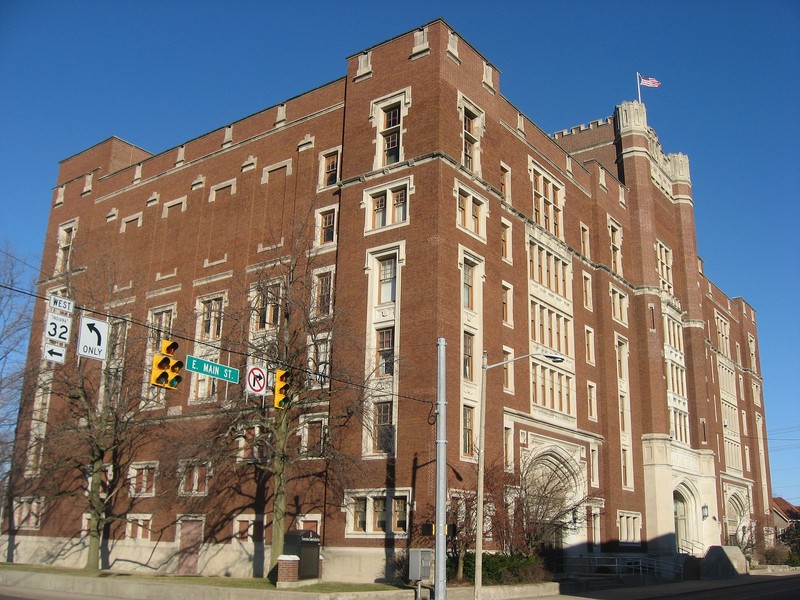Masonic Temple
Introduction
Text-to-speech Audio
Images
Masonic Temple in Muncie, Indiana

Backstory and Context
Text-to-speech Audio
A parade through downtown Muncie culminated in rituals to lay the cornerstone of the Masonic Temple building on October 30, 1923. The structure was finished by the fall of 1926 and was the third building belonging to the Masons in Muncie. The Masons founded their first lodge in 1842. Over time, the numbers of members grew and a larger building was called for. The red brick building rests on a limestone and concrete foundation and is detailed in limestone along the octagonal turrets and the parapets. The central section is a tower with the Masonic symbol on the south parapet. The main Tudor style entryway in the base of the tower features a limestone panel above the arched doorway inscribed "Masonic Temple." Two secondary entrances flank the central tower. Three sets of double bronze doors to the west of the central tower lead to an auditorium, with the inscription "Temple Auditorium" visible above.
The Masonic Temple contained the city's first large public theater venue, which was added into the plans after the original design was finished and the foundation had already been poured. The 1,300-seat facility features a horseshoe-shaped balcony and lobby space decorated in gold leaf, to the west of the main entrance. A banquet room decorated in marble with terrazzo flooring with a kitchen beyond were placed to the east of the main entrance. The Red Cross Room is near the center of the building on the third floor, with a balcony on one end and decorated with Egyptian motifs, gold leaf, and plaster molding.
Gustav Adolph Brand, a German-born artist, designed murals painted on the interior of the building (see below for a link to photographs of the interior including the murals). The scenes were painted in Chicago and include scenes depicting Masonic rituals and Bible scriptures. Most of the murals are in the Blue Room on the third floor.
The Muncie Civic Theater was located in the building between 1931 and 1961. Over the years, numerous other arts and civic organizations used the building. By 1999, community leaders took over the building as the number of Mason members decreased. Eventually, two organizations—the Community Civic Center and Muncie Center for the Arts—housed in the building merged to form the Cornerstone Center for the Arts in 2005, which remains in operation today. Five Masonic groups continue to use the building for meetings and other gatherings. The Masonic-Community Building Foundation was formed in 1989 to manage restoration and repair efforts, and was reorganized in 2001 as the Community Arts & Building Foundation, Inc.
Sources
"Cornerstone History". Retrieved 4-31-2015. https://cornerstonearts.org/about/cornerstone_history Gooden, James. "Masonic Temple", National Register of Historic Places. 9-27-84.
Hein, Dawn. Becky Lawin. The Masonic Temple Building, Delaware Lodge 46 - History. September 6th 2000. Accessed May 2nd 2020. https://sites.google.com/site/delawarelodge46/history.
